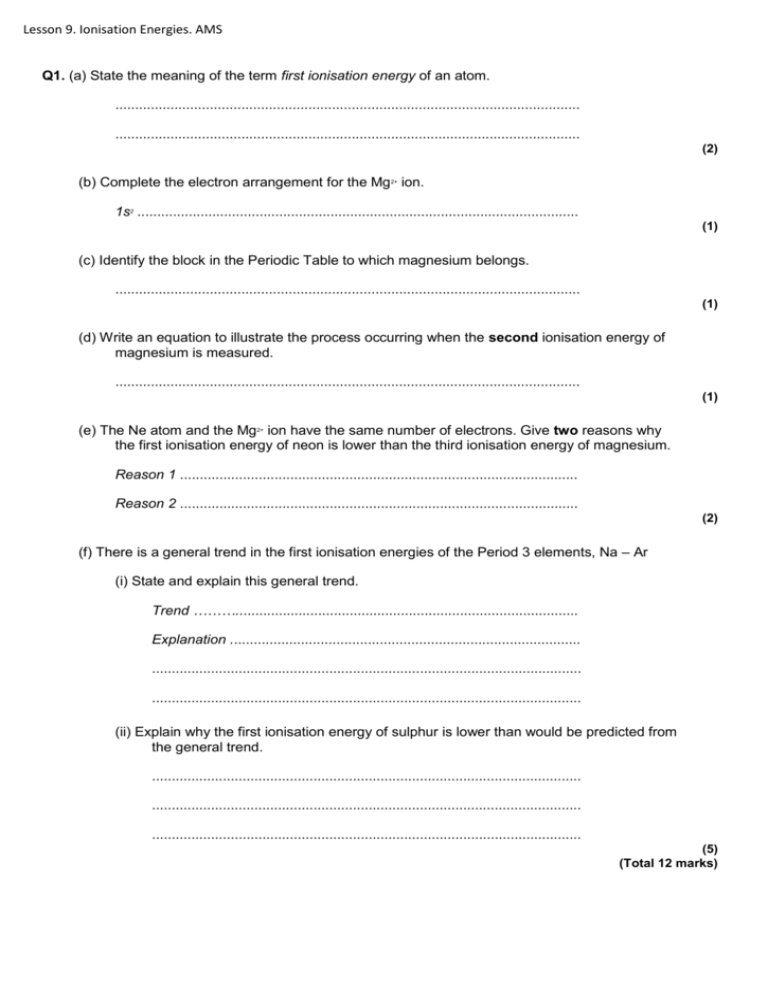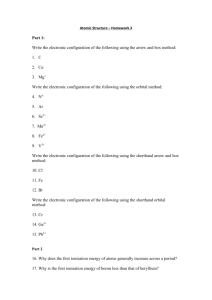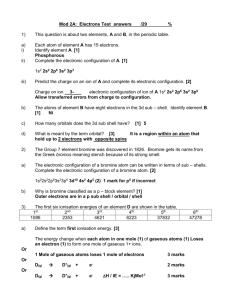L9 PPQ, MS and Notes
advertisement

Lesson 9. Ionisation Energies. AMS Q1. (a) State the meaning of the term first ionisation energy of an atom. ...................................................................................................................... ...................................................................................................................... (2) (b) Complete the electron arrangement for the Mg2+ ion. 1s2 ................................................................................................................ (1) (c) Identify the block in the Periodic Table to which magnesium belongs. ...................................................................................................................... (1) (d) Write an equation to illustrate the process occurring when the second ionisation energy of magnesium is measured. ...................................................................................................................... (1) (e) The Ne atom and the Mg2+ ion have the same number of electrons. Give two reasons why the first ionisation energy of neon is lower than the third ionisation energy of magnesium. Reason 1 ..................................................................................................... Reason 2 ..................................................................................................... (2) (f) There is a general trend in the first ionisation energies of the Period 3 elements, Na – Ar (i) State and explain this general trend. Trend ………....................................................................................... Explanation ......................................................................................... ............................................................................................................. ............................................................................................................. (ii) Explain why the first ionisation energy of sulphur is lower than would be predicted from the general trend. ............................................................................................................. ............................................................................................................. ............................................................................................................. (5) (Total 12 marks) Q2. (a) When aluminium is added to an aqueous solution of copper(II) chloride, CuCl2, copper metal and aluminium chloride, AlCl3, are formed. Write an equation to represent this reaction. ...................................................................................................................... (1) (b) (i) State the general trend in the first ionisation energy of the Period 3 elements from Na to Ar. ............................................................................................................. (ii) State how, and explain why, the first ionisation energy of aluminium does not follow this general trend. ............................................................................................................. ............................................................................................................. ............................................................................................................. ............................................................................................................. (4) (c) Give the equation, including state symbols, for the process which represents the second ionisation energy of aluminium. ...................................................................................................................... (1) (Total 6 marks) Q3. The diagram below shows the values of the first ionisation energies of some of the elements in Period 3. (a) On the above diagram, use crosses to mark the approximate positions of the values of the first ionisation energies for the elements Na, P and S. Complete the diagram by joining the crosses. (3) (b) Explain the general increase in the values of the first ionisation energies of the elements Na–Ar. ...................................................................................................................... ...................................................................................................................... ...................................................................................................................... ...................................................................................................................... (3) (c) In terms of the electron sub-levels involved, explain the position of aluminium and the position of sulphur in the diagram. Explanation for aluminium ............................................................................ ...................................................................................................................... ...................................................................................................................... Explanation for sulphur ................................................................................. ...................................................................................................................... ...................................................................................................................... (4) (Total 10 marks) M1. (a) enthalpy/energy change/required when an electron is removed/ knocked out / displaced/ to form a uni-positive ion (ignore ‘minimum’ energy) 1 from a gaseous atom (could get M2 from a correct equation here) (accept ‘Enthalpy/energy change for the process...’ followed by an appropriate equation, for both marks) (accept molar definitions) 1 (b) 1s2 2s22p6 (accept capitals and subscripts) 1 (c) ‘s’ block (not a specific ‘s’ orbital – e.g. 2s) 1 (d) Mg+(g) → Mg2+(g) + e– or Mg+(g) + e– → Mg2+(g) + 2e– or Mg+(g) – e– → Mg2+(g) 1 (e) Mg2+ ion smaller than Ne atom / Mg2+ e– closer to nucleus (Not ‘atomic’ radius fo Mg2+) 1 Mg2+ has more protons than Ne / higher nuclear charge or e– is removed from a charged Mg2+ion / neutral neon atom (accept converse arguments) (If used ‘It’ or Mg/magnesium/Mg3+ etc. & 2 correct reasons, allow (1)) 1 (f) (i) trend: increases (if ‘decreases’, CE = 0/3) 1 Expln: more protons / increased proton number / increased nuclear charge (NOT increased atomic number) 1 same shell / same shielding / smaller size 1 (ii) QoL reference to the e– pair in the 3p sub-level (penalise if wrong shell, e.g. ‘2p’, quoted) 1 repulsion between the e–in this e–pair (if not stated, ‘e– pair’ must be clearly implied) (mark M4 and M5 separately) 1 [12] M2. (a) 2Al + 3CuCl2 → 2AlCl3 + 3Cu; (accept multiples/fractions) OR 2Al+ 3Cu2+ → 2Al3+ + 3Cu; 1 (b) (i) increases; 1 (ii) lower than expected / lower than Mg / 1 less energy needed to ionise; e– removed from (3)p sub-level; 1 (‘e– removed’ may be implied) of higher energy / further away from nucleus / shielded by 3s e–s; 1 (c) Al+(g) → Al2+(g) + e–; 1 (d) trend: increases; 1 more protons / higher charge on cation / more delocalised e– / smaller atomic/ionic radius; stronger attraction between (cat)ions and delocalised/free/mobile e– 1 OR stronger metallic bonding; 1 [9] M3. (a) 1 (b) Increased nuclear charge / proton number (1) NOT increased atomic number Electrons enter same shell / energy level OR atoms get smaller OR same shielding (1) Stronger attraction between nucleus and (outer) electrons (1) Q of L 3 (c) Explanation for aluminium: (third) electron in (3)p sub-shell (1) Sub-shell further away from nucleus OR of higher energy (1) OR extra shielding from (3)s Explanation for sulphur: Pair of electrons in (3)p orbital (1) Repulsion between electrons (1) tied to reference to e– pair in M3 Penalise ‘2p’ once only 4 [10] E1. Candidates tended to score a little better on this question than on question 3 but, overall, the question was not well answered. Part (a) was generally well done, although incomplete answers were quite common. The most common error was to omit reference to gaseous atoms. Parts (b) and (c) were often well answered; however, in part (d) incorrect ionic charges and missing or incorrect state symbols were quite often seen. Part (e) was poorly done. Many candidates referred to difference in the number of electron shells present in the two species despite being told in the question that they had the same number of electrons. Some candidates attributed the difference to a special stability enjoyed by neon as a consequence of it having a full outer electron shell. Clearly, the majority of candidates failed to appreciate the significance of the two species having the same number of electrons. Many answers referred to ”It’, magnesium or Mg, rather than correctly identifying the species being discussed. In part (f), candidates are asked to demonstrate their understanding of a trend required in the specification. While part (f)(i) was often competently dealt with, answers in part (f)(ii) frequently lacked sufficient specific detail to be awarded credit. Often, candidates failed to identify the electron pair from which from which the first electron would be removed, or to explain the relatively low first ionisation energy of sulphur in terms of repulsion between the electrons in this electron pair. Vague phrases such as ‘electron pairs repel’, or a reference to a more stable halffilled shell being formed, earned no credit. E2. While less able, (or less well prepared,) candidates struggled with this question, the majority coped quite well. The equation in part (a) was usually correct, although it was not unusual to see Al2, Al3+ or Cu2 in the equation, or for the equation to be incorrectly balanced. Most candidates correctly identified an increase in ionisation energy across the group; however, the explanations in part (b)(ii) were frequently vague and unconvincing. In particular, statements that the electron in aluminium as easier to remove, rather than making direct reference to the lower ionisation energy of aluminium, failing to specify the 3p electron as being the first electron to be removed from aluminium or vaguely referring to extra shielding, were quite common. In part (c) some candidates did not start their equation with Al+ ions and many more either omitted the state symbols completely or used the wrong one. The majority of candidates correctly identified a rising trend in the melting point of the three metals in part (d) but the explanations offered were diverse and frequently incomplete or wrong. Those candidates who did correctly attribute the trend to an increase in proton number or to the number of delocalised electrons often proceeded no further, or simply referred, without explanation, to an increase in metallic bonding. Many explanations were poor, and references to molecules, ionic bonding, van der Waals' forces and even hydrogen bonding were frequently seen. E3. Many candidates correctly positioned the crosses in the diagram, but errors were not uncommon. In some cases, the cross for sodium was omitted. Other common errors were to position the cross for sodium at the same level as that for aluminium, to place the cross for phosphorus below that for silicon and to place the cross for sulphur level either level with that for phosphorus, or level with that of silicon. Given that the questions in parts (b) and (c) are frequently asked, and so should be an essential part of a revision programme, the answers offered by many candidates were disappointing. The better candidates were well prepared and so scored well on this question; others lacked much of the basic knowledge required in this section of the specification. In part (b), many candidates attempted to explain the deviations from the general increase in ionisation energy across the period, rather than explaining the general increase itself, as required by the question, and so failed to earn the marks allocated to part (b). Where the explanation offered in part (b) helped to clarify an answer to part (c), which did require an explanation of the deviations from the general trend, credit for the marks allocated to part (c) was given. While some clear, concise and accurate explanations were seen in part (b), many attempts were vague. All that was required was for a link to be established between the increased nuclear charge of smaller atoms having no change in shielding and an increase in the attraction between the nucleus and the outer electrons. Many explanations lacked precision and failed to establish such a link. The phrase effective nuclear charge was incorrectly used as an explanation by some candidates. Many explanations in part (c) similarly were incomplete and lacked precision. Many candidates correctly identified the outermost electron in an aluminium atom as being in the 3p sub-level. The second mark, for explaining why this electron is more easily lost was less frequently earned. Some candidates successfully explained the second point, but omitted to state the location of the outermost electron. Some candidates referred to an increase in the shielding of the outer electron but omitted to identify the electrons responsible for this increase. In some cases, candidates simply stated that aluminium was in the 3s with no reference at all being made to electrons. While some candidates clearly explained the drop in ionisation energy between phosphorus and sulphur, many others vaguely attributed this deviation from the general trend to mutual repulsion, or to repulsion between electrons, without identifying the location, or the paired nature, of the electrons involved. Some vague references to the increased stability of the electron arrangement present were also seen. Resource currently unavailable.








